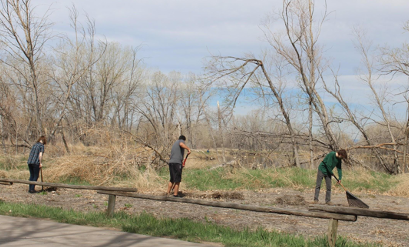2022, SACRAMENTO, CALIFORNIA, USA

Tokay High School students Kendra Goudie, Harmandeep Batth, Prabhleen Kaur, Conner Gallo are involved in the Sustainability Committee for the NorCal Science Festival, an event held annually at their school. They realized that actions focused on sustainability for the event can also promote positive environmental behaviors year-round on their campus. Their Caring for Our Watersheds project seeks to prevent the flow of litter into the storm drains that lead to the river from Tokay High. The group did an analysis of the waste disposal system on campus and found that there are very few trash receptacles and no recycling bins in areas of high student occupancy at mealtime. Through this analysis and prior clean-up events, they also identified areas on campus with the most littering issues. To address the issues, the team purchased upcycled wine barrels to utilize as trash and recycling receptacles. They will also install signage to encourage use and show students which items can be placed in the barrels. In addition, the group also plans on co- sponsoring “Litterati” clean-up challenges, in partnership with the City of Lodi, to promote a litter-free campus through student behavior and action.
Archives
Starting a Compost System on Campus
2022, SACRAMENTO, CALIFORNIA, USA
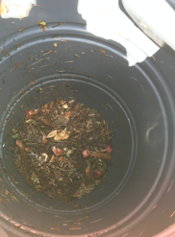
Samuel Hartsell-Jenkins and Kirby Slagle from The MET Sacramento High School developed a solid project to start and maintain a composting system on campus to reduce the amount of food waste going to landfills. By composting organic waste, the school will reduce its contribution to greenhouse gasses, particularly methane, which is produced by anaerobic decomposition of organic matter in landfills. The team started to implement their plan in the spring of 2022, and will continue to educate and engage students in the composting process during the upcoming school year. Caring for Our Watersheds funding helped them purchase the bins for food waste collection and composting, as well as materials needed to maintain the compost, and promote use of the system.
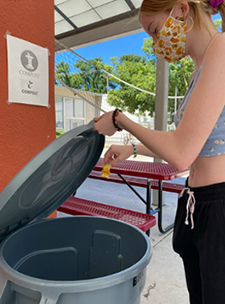

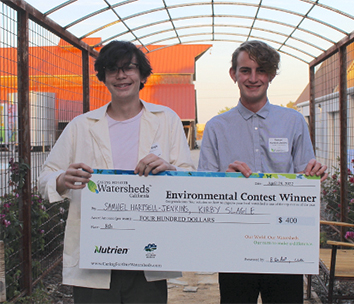
Pollinator and Drought-tolerant Garden
2022, SACRAMENTO, CALIFORNIA, USA

Georgia Walder and Rory Strain, students at George Washington Carver School of Arts and Sciences, are concerned about the decline of pollinators. Through their research, they learned that loss of habitat, as well as pesticide drift are some of the threats to pollinator populations. They wanted to create a pollinator friendly habitat free of pesticides to support native bees, butterflies, and other beneficial insects. Georgia and Rory, well aware of the multi-year drought in California knew they wanted to create their garden with water conservation in mind. Their garden plan included the use drought tolerant plants and drip irrigation to efficiently water them to help them get established. The pair also used their artistic creativity to create an enticing, beautiful space. The team utilized social media to share their project, plan, and progress and to educate others in their community on how to help pollinators thrive.

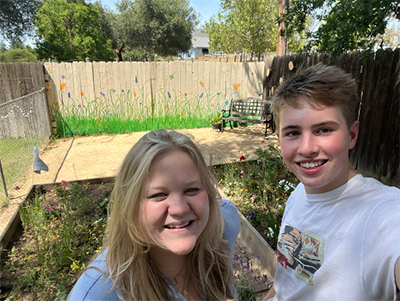
Composting on Campus
2022, SACRAMENTO, CALIFORNIA, USA
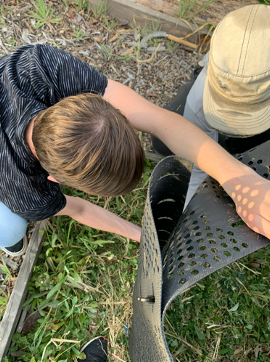
Alice Lanier and Nicholas Connors, student at George Washington Carver School of Arts and Sciences, were concerned about the food waste being generated on their school’s campus. Through their research, they learned that when this food waste ends up buried in a landfill, it undergoes anaerobic decomposition, which releases methane, a potent greenhouse gas. In their proposal, they enthusiastically declared “we believe that we can create a compost system that will help make our school green and educate others on the power of composting.” Alice and Nic reached out to the local community compost collective, ReSoil Sacramento, to get advice and learn about different techniques and options to compost at school. They bought collection bins and created signage to collect food waste at lunch. They also bought tools they needed to transport the food waste to the garden area, as well as materials such as straw to aid in the composting process. As traditional compost bins can fill quickly, ReSoil suggested composting some of the food scraps directly into existing garden beds, which proved successful. Alice and Nic were grateful for funding from Nutrien, which allowed them to learn from community experts, implement their project, and engage fellow students in the process.

Campus Pollinator Garden
2022, SACRAMENTO, CALIFORNIA, USA
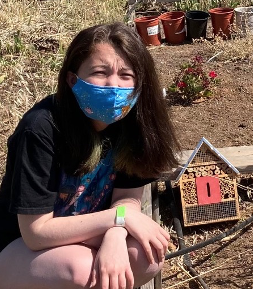
Josephine Rios and Natalie Durling, students at George Washington Carver School of Arts and Sciences, took on a project that both beautified their school’s campus and created habitat for native pollinators. The duo, aiming to attract a variety of pollinators to the school garden, did their research (or “beesearch” as they called it) on specific species to plant and bee hotel to install. They also installed drip irrigation in their plot, which will serve as a demonstration garden highlighting water-wise, and pollinator friendly landscaping practices.

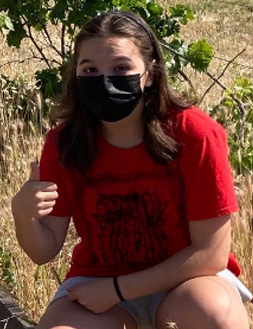
Campus Tree Planting
2022, SACRAMENTO, CALIFORNIA, USA
Grant High School students Mai Lee, Husia Lee, and Visay Phasavath proposed and implemented a drought-tolerant tree planting on their school’s campus. The trees will provide shade, help capture and store carbon dioxide from the atmosphere, as well as create an attractive space on campus for students to gather. The team reached out to Sacramento Tree Foundation for assistance, and the organization provided trees, as well as guidance on tree species, planting techniques, and proper care of the saplings. Fellow students Joscelyn Lor, Tatiana Blackmon, Ariya Vue’s proposal also helped obtain funding and materials needed to make the tree planting project a success.

Promenade Pollinator Planting
2022, SACRAMENTO, CALIFORNIA, USA

Grant High School student Landon Lo’s proposal was to support pollinators by creating and expanding habitat on the school campus. Helped by fellow students Valeria Sanchez, Adan Lopez, Chris V. and others, he was able to see his project through and transform 4 raised planter beds into gardens boasting a variety of pollinator-friendly, drought tolerant plant species. Their plantings surrounded a beautiful “pollinator totem” to create a beautiful space on campus.
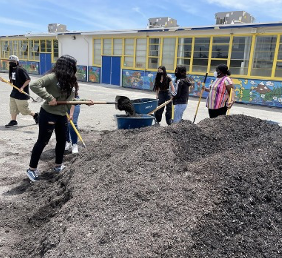
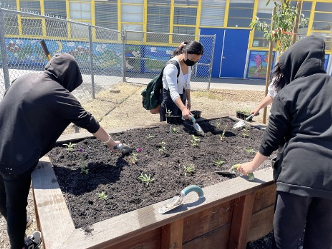
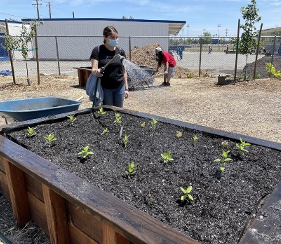

Project Yellow
2022, Selkirk, MB, Canada
Jerzy is a student from Lord Selkirk Regional Comprehensive Secondary School in Selkirk, MB. When she was posed with the question, “What can I do to improve my watershed?”, she was buzzing with ideas!
With Project Yellow, I hoped to improve the state of our watershed’s bee population. In order to do so, I handed out packets of Anise Hyssop seeds; a plant very attractive to pollinators. My workplace gave me permission to hand out a packet with each sale, which helped me give away over 80 of the 100 packets. Whilst explaining my project to customers, they showed a genuine interest in helping. It only took two shifts to clear out the seeds! The rest of the seeds were given to friends and family. I am very pleased with the level of community involvement as it will take one to save our watershed.
The Story of Frog Plains
2022, West Kildonan Collegiate, Winnipeg, MB, Canada

When Breanna and Rae from West Kildonan Collegiate in Winnipeg, MB heard that a protected wetland in their area was not being upkept, they decided they wanted to do something about it! They organized a group of students to go in, pick some weeds and invasive species, and plant some new native species to bring the area back to its former glory!
“We want to help and connect our community by bringing back the beauty that this wetland once was.”
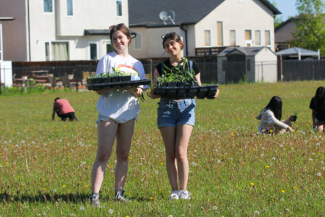
The girls partnered with Edmond Partridge Middle School so that they could educate the next generation and have them help with the project. They also made a partnership with the Aki Learning Centre who donated some plants including Narrow Leaf Sunflower and Purple Prairie Clover. They also got some extra little packages of seeds to give to students to plant elsewhere in the community and spread their project beyond Frog Plains!

Our Blooming Watershed
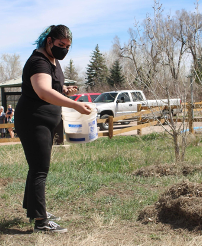
2021, Greeley Central High School, Greeley, Colorado, USA
Kimberly Gonzalez Jimenez
Pollinators are an important component to the health of our watersheds. They contribute to the diversity of our watershed and the existence of our plants. Pollinator gardens as recommended by the U.S. Forest Services and the United States Department of Agriculture as pollinators are known to help boost pollinator populations. That’s why Kimberly decided to plant a local pollinator garden. The garden was planted within the Pouder River Panch Natural Area (a city park) in Greeley, Colorado. It includes fourteen different species of flowers and plants to attract pollinators. This will in result cater to our declining pollinator population and provide them with a chance at steading their numbers so they can continue serving our watersheds and us!
